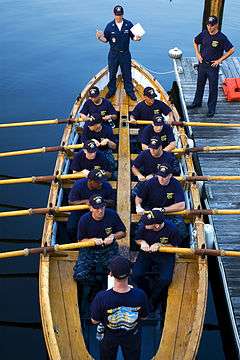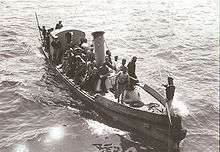Ship's boat
Ship's boats are utility boats carried by larger vessels to act as tenders, among other roles. Boats had different names depending on hull form, rig, size and role during the Age of Sail, this nomenclature persisting to the present, especially in military circles, long after most distinctions have disappeared.

Types
Ship's boats that might be carried by a sailing ship include:
- Admiral's barge
- Captain's gig
- Cutter
- Dinghy
- Jolly boat
- Longboat
- Pinnace, originally an eight-oared boat (a larger full-rigged pinnace is a different class of vessel)
- Yawl, similar to a pinnace, but smaller, usually with four or six oars[1]
Age of sail
History
In the age of sail, a ship carried a variety of boats of various sizes and for different purposes. In the navies they were: (1) the launch, or long-boat, the largest of all rowboats on board, which was of full, flat, and high built; (2) the barge, the next in size, which was employed for carrying commanding officers, with ten or twelve oars (3) the pinnace, which was used for transporting subordinate officers, with six or eight oars (4) the yawl, a smaller pinnace; (5) the cutter, which was shorter and broader than the long-boat and used for the transfer of goods (6) the jolly boat, used for light work; (7) the gig, a long narrow boat, employed for expeditious rowing and fitted with sails, and belonging to the captain.[2][3]
A merchant ship usually carried on board: (1) the launch or long-boat; (2) the sciff, the next in size and used for towing or kedging; (3) the jolly boat or yawl, the third in size (4) the quarter-boat, which was longer than the jolly-boat and named thus because it was hung on davits at a ship's quarter; (5) the captain’s gig, which was one of the quarter boats.[2]
Roles
One of the main roles of a ship's boat was to act as a taxi to move stores and people between shore and ship, and between ships.[4] Although some boats were general purpose in nature, boats such as the Captain's gig and the Admiral's barge were for the exclusive use of officers. It was also the role of a military vessel's boats to act as landing craft, to deliver boarders and cutting-out (night attack) parties. Boats were also sometimes armed with a single bow-mounted, forward-firing, smoothbore cannon to function as small gunboats, boats so equipped would support landing operations and act as picket boats for ships at anchor.
When a ship was becalmed, mastless, run aground or otherwise unable to move, a ship's boat provided a source of motive power. The ship's anchor and cable would be rowed a distance from the ship before being laid, the crew would then man the ship's capstans to haul the ship forward, known as kedging or warping, this would be repeated as many times as needed.
The ship's boats could also when needed be used as a lifeboats and rescue boats.
Storage
During the age of sail the ship's boats of larger ships of the line would be stowed upon the deck, sometimes nested one atop the other. Boats would be deployed and recovered by davits with some vessels carrying a single small boat suspended astern. In the smallest vessels a ship's boat was also on occasion towed astern. Boats stored on deck in tropical climates were usually partially filled with water to prevent the wooden hull planks drying out and shrinking, which would make the boat leak once it was placed in water until the wood swelled up again.
When a warship was going into action her boats were usually towed astern. This freed space on the deck, reduced the possibility of the boats being damaged by gunfire and prevented the boats becoming a major source of dangerous splinters if they were left on deck. If a ship was spending a long period at anchor (such as during a spell in a home port when the boats would be regularly employed moving people and supplies between ship and shore) it was common to rig a boat boom perpendicular to the hull of the ship. The boats would then be moored to this, ready for use as required. This saved the manpower and time needed to hoist a boat into and out of the water whenever it was needed.
Age of steam

Steam ships continued to carry ships boats, sometimes armed. For instance, a long-serving 19th century British picket boat, carried on capital ships, was a 50-foot (15 m) model introduced in 1867 which saw wide service in World War I and even some limited service in World War II. The typical main armament during most of this boat's service life was a Hotchkiss 3–pounder, adopted by the Royal Navy in 1886.[5]
Present day
Ships today from large cruise ships to small private yachts continue to carry ship's boats as tenders and lifeboats. Aboard military vessels ship's boats, often rigid-hulled inflatable, continue to do many of the things expected of their Age of Sail predecessor.
References
- "Yawl, n.1". OED Online. Oxford University Press. September 2019. Retrieved 19 November 2019.
- Young, Arthur, and James Brisbane. Nautical Dictionary: Defining the Technical Language Relative to the Building And Equipment of Sailing Vessels And Steamers, Seamanship, Navigation, Nautical Astronomy, Naval Gunnery, Maritime Law And Commerce, General And Particular Average And Marine Insurance, And Other Terms Relating to Maritime Affairs. London: Longman, Green, Longman, Roberts, & Green, 1863, pp. 44-45.
- Folkard, Henry Coleman. The Sailing Boat: a Treatise On English And Foreign Boats, Descriptive of the Various Forms of Boats And Sails of Every Nation; With Practical Directions for Sailing, Management. London: Longman, Green, and Roberts, 1863.
- Knox, Dudley, ed. (1940). Naval Documents Related to the Wars With Barbary Powers, Naval Operations from 1802 to 1803. II. U.S. Gov't Printing Office, pp. 294, 300 (recounting when ship's boat, after ferrying Naval Captain to his vessel offshore, on returning capsized in high winds, drowning the midshipman in command and several sailors)(letter Captain Carmick to Lt. Col. Burrows, U.S Marine Corps., 15 Oct 1802).
- Richard Kemp. "New 28mm Royal Navy Picket Boat from HLBS". The Miniatures Page. Retrieved December 28, 2015.